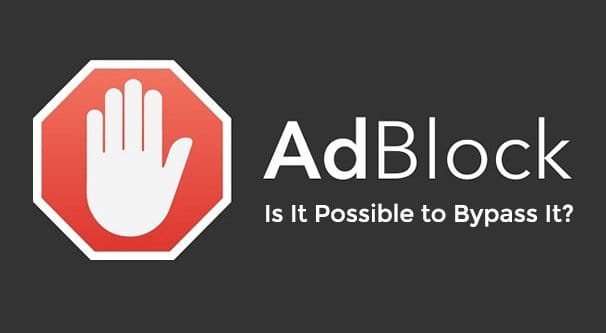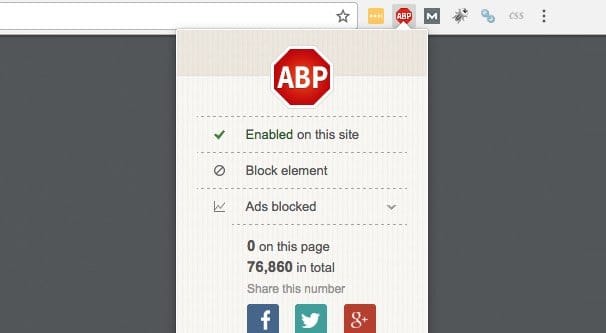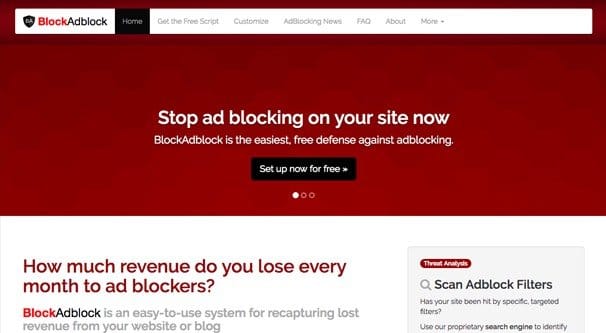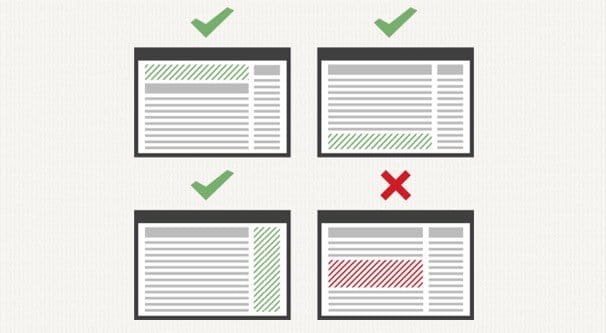Can You Modify Your Website to Bypass AdBlock Plus?

Ads and Ad-blocking software are in an ongoing arms race, one that many users don’t even see in their daily lives. On the one hand, you have websites looking to monetize their content via ads that pay them per view, per click, or per conversion. On the other hand, you have users who don’t want disruptive ads all over their browsing experience. If the websites win, users have no options but to consume advertising regardless of their preferences. If the users win, websites have far fewer ways to make money, and many will simply fold and close up shop. There’s a delicate balance to be found, but there are always people trying to push past the line in the sand, so it’s likely that this war will continue indefinitely.
A History of Ad Blocks
Before the creation of ad blockers, websites were free to monetize with ads as they saw fit. Many sites kept it light, adding a banner up top or along the side of their content. Others decided to go all-in with it, putting banners and monetized links in every position possible, including redirects and pop-ups. With some scripts, you can keep a user locked into a redirect cycle from which they can never escape. Of course, that’s a good way to piss off readers and lose views, but some people considered the brief, minor payout worth the sacrifice to long term growth.
Then users got fed up of the over-prevalence of advertising and their own lack of control. They created ad blockers, which identified ad code and prevented it from rendering on the website. This often worked via blacklisting the URLs of the ad services, like DoubleClick and Chitika. Over time, these extensions grew more sophisticated, to detect more ads and have fewer false positives.
For a while, certain types of ads would make it through, as the extensions didn’t have a valid way to block them. I personally remember a time where YouTube was unusable with an ad blocker, because video ads wouldn’t load, and the videos wouldn’t start until the ad had played. This is no longer the case; the blocking extensions are just that good.
Google also got involved at some point along the line, putting pressure on website owners that cram too many ads into their sites. While users with ad blockers might represent under 5% of the traffic a site received, Google could drive their ranking down and absolutely tank their traffic entirely. Meanwhile, ad blocking has grown more and more prevalent.
Facts About Ad Blocking
PageFair performs a study each year, and publishes a report about “the state of the blocked web” at the start of the year.
Here’s what they’ve found for the start of 2017.
- 11% of global internet users block ads on the web, which represents a 30% year over year growth rate.
- 74% of adblock users say that if a site has a wall that prevents them from loading content until they disable adblock, they will leave the site.
- 77% of adblock users say they are willing to view some ads, just not all ads indiscriminately.
- Mobile adblock usage in the Asia-Pacific region grew by 40% last year.
- The number one reason users block ads is because the ads are interrupting their experience or serving malware.
All of this makes sense, if you think about it, and I’ll mention a few of these statistics later on.
Why Ad Blocking is Good
Yes, as a site looking to monetize via ads, ad blocking represents potentially significant lost income. The average adblock user is 18-24 years old, has a bachelors degree, and is relatively tech savvy. In fact, college campuses are one of the primary vectors of spreading ad blocking software knowledge. If your primary audience includes that kind of user, you’re looking at more than the average level of ad blocking on your site.
Ad blocking is, however, a generally good thing. Most ad blocker users are perfectly willing to whitelist a site they like and whose ads they don’t find offensive or risky. The use of ad blocking software protects users from ad-served malware. Security is a huge concern on the web, computer viruses can be immensely destructive, and the risk to the average user is huge. There’s no “don’t download strange files” sensibility involved when a banner ad simply injects code into your computer.
Ad blocking also puts negative pressure on sites that try to overload their sites with spammy, disruptive, or otherwise negative experiences. I can’t tell you how often I’ve visited a website and found my browser redirected to a tab with a box that pops up when I try to leave, making me click to close it and then click again to leave, and even then it often opens another instance before I fully close it. No one wants their browser hijacked and their experience interrupted, particularly if they’re doing something important, like research.
Many ad blockers also have functionality beyond simply blocking ads. They’re selective element blockers with pre-programmed ad lists, but they can block any element of a page.
- You can block specific elements of a page layout, like the chat bar on Facebook or the YouTube comments section.
- You can block code strings, like the JavaScript that Twitter uses to generate image previews in its feed, to make Twitter a faster, more streamlined experience.
- You can block tracking cookies and elements like the Facebook Pixel, to not just prevent advertising, but prevent tracking and remarketing.
- You can block a list of known malicious domains full of spyware, malware, viruses, and other nasties.
- You can block videos on sites that play automatically with no option to disable them.
- You can block social locking apps, often with the consequence that they reveal the content they were hiding, because they don’t load to block it.
However, I fully understand the goal of putting pressure back on the ad block users, to get them to whitelist your site and allow you to monetize them. There are four main ways to try to solve this problem.
The Adblock Obfuscation
The first solution is to bypass the ad blocker itself. To do this, you need to understand how an ad blocker works. They look at your site for code that matches code in their list, and they prevent that code from loading. The code could be anything from an image URL to *.js to block all JavaScript.
You might think that you can simply look at the list and avoid using anything on that list, but this has two main flaws. The first flaw is that the major ad networks are all on the list. If you want to use Google Ads, Bing Ads, or any other ad service, you’re going to be blocked. The second flaw is that these lists are always changing. Not only can individual users add elements to their own personal lists, the developers and the people who maintain lists can add elements they think should be globally blocked. There are also a wide variety of lists, so you’re not always able to find a loophole.
The most common way to accomplish obfuscation is to hide the code that pulls your ads. Similar to how affiliate marketers use cloaking to hide the destination of their links from people who would see and click on them, you can hide the actual code by putting it in external files that are called and loaded, or through some other means.
The main problem with this is simply that ad blockers update. When your cloaking method is discovered, blocked, and reported enough times, updates will be added to the ad blockers that will block your cloaking and the ads behind them again. You will have become part of the ongoing war, and there are professional developers who do nothing more than try to circumvent ad blockers; you have to work pretty hard to contribute something innovative to the battle.
The Adblock Wall
The second method to circumventing an ad blocker is to set up an adblock wall. If you’re familiar with using ad blockers and you’ve been around the web in the last few years, you might have encountered this on Forbes. Forbes is somewhat notorious for being on the front lines of the war against ad blockers. Their “welcome” page, that loads the first time you visit their site each day, doubles as a filter for people using ad blockers. If you have a blocker turned on and visit Forbes, the page will load but the elements on it will not, which includes the link to proceed to the next screen and the code that tells Forbes that you’ve visited before and thus not to redirect to that page again.
Now, this welcome page has changed form many times, as ad blockers get around it, again as part of the ongoing arms race. For the moment, it seems as though they have admitted some level of defeat, even.
I’ll refer again to the stats up at the top. Adblock walls turn a potential viewer into a bounce at a very high rate; 74% of adblock users simply leave when faced with such a wall. I’m guilty of this myself, though if the content is something I particularly value, I might temporarily unblock the site long enough to view it. I still have a few URLs blacklisted because they pulled this trick, and I haven’t even bothered to check to see if they’ve removed it.
This is the sort of attitude you’ll encounter if you try to set up an adblock wall. Many of the people who are caught by it, who might otherwise become readers or customers, or who might have been loyal readers before you implemented the wall, will leave the site entirely until you remove it, if they ever return at all.
The Adblock Guilt
The third way to circumvent an ad blocker is to point out that the user is blocking ads, that you need ads to keep the site running, and that they can really help you out by whitelisting your site. You can see this in action if you have an adblocker enabled and visit this site, all the way at the bottom of the page.
The idea here is that you’re simply trying to guilt your adblock users into supporting you, by mentioning that their actions have a direct effect on your ability to run the site on an ongoing basis. It’s up to them whether or not to believe you, but in the mean time you aren’t disrupting their experience.
The key to getting this to work, in my mind, is a two-fold approach. On one hand, you need to assure them that your ads aren’t disruptive, they will never be objectionable, and that they are minimal in terms of impact on the user. If they whitelist your site and are assaulted with overlays, redirects, noisy animated ads and pop-unders, you can bet they’ll immediately turn their blocker back on. On the other hand, if they whitelist your site and only see a tame banner ad with relevant content to their interests, they’ll not just keep your site whitelisted, they’ll potentially even click the ad.
The second element is to provide feedback for reporting ads that are malicious or objectionable. If they whitelist your site and an ad tries to download a file, have a link they can use to report the ad. Google ads do this automatically, but it helps if you have a way to get feedback so you know when it’s happening on your site.
I’m going to be honest here; this is generally the route you should take with your adblock circumvention, if you’re dead-set on doing it. You’ll want to use a system like CopeJS, which also has an engine for paywalls for ad block users. Offer them a paid membership that gets them an ad-free experience on your site. It’s only $24 per month, which isn’t even that bad.
Fixing Your Ads
This fourth method is probably not going to work, but it’s the ideal end goal of ad block users. Remember those stats above, where most ad block users said that they’re willing to view some ads, just not all of them? That’s what you want to target. A few discrete ads are acceptable and encouraged. It’s only when they get disruptive, when they’re malicious, or when they have content the user doesn’t want to see – like porn, not just off-target content – that they deserve to be blocked.
Unfortunately, ad blockers don’t have a sanity setting. It’s all or nothing. A user that has it enabled won’t be able to see that your site has reasonable ads unless they find out manually, and they won’t unless you use the third method to tell them. The only way to reach this ideal is if everyone had sane ads, and there will always be marketers who push the limit and get slapped with the blocker because of it. The best you can do is make your site reasonable, use a guilt trip, and hope you’re whitelisted.
AdBlock Plus Whitelist
All of the above information has been about any ad blocker in general, but the title specifically calls out AdBlock Plus. There are two reasons for this. The first is that AdBlock Plus is one of the largest and most frequently used ad blockers out there. The second is that there’s one method you can use for them that won’t work with other blockers.
AdBlock Plus added a whitelist to their program some time ago, which caused a lot of controversy and some adoption of other blockers. Anyone can apply to have their website added to the whitelist.
All you have to do make sure your ads meet their criteria for acceptable ads, found here. If they do, you can fill out this form to have your site reviewed. Within 10 days, if you’re accepted, the company will contact you with an agreement. Sign the agreement and they will add you to the whitelist and create a topic about your site in their community forum, where the community can raise concerns if they see your site change or if they see something objectionable. That’s it!
 ContentPowered.com
ContentPowered.com












Thanks for coming up with a number of solutions. Adblocking has surged in recent years and has become big problem for publishers. Adblocking issues are needed to tackle. As yet I have used Adzsafe. It disables adblocker right from user’s browser and lets my ads to be loaded and viewed safely. But I would definitely try these smart solutions. Thank you.